The hot rolling mills are those industrial arrangements for processing metals at such temperature whereby the metals’ shape and structure could be changed or modified to a required form. During this process, the metal is heated above the recrystallization temperature, whereby its grains get softened, and hence it could easily be rolled. The hot rolling mills cause metal slabs, billets, or blooms to pass through a series of powerful rollers that convert them into thin sheets, plates, or bars.
The great benefit of this process is that at high temperatures, the metal becomes ductile and malleable, hence its deformation becomes easy and effective. Hot rolling mills produce steel, aluminum, copper, and alloys that find widespread application in construction, automotive, and manufacturing industries.
Hot rolling reduces the internal stresses of the metal and improves the surface quality of the metal. The final product is smooth with even dimensions, ideal for high-strength applications. Mills like that then become very important in industries as they make mass production affordable and time efficient.
What is Hot Rolling Mill Process?
Hot rolling mills are the industrial processes concerned with the reshaping and refinement of metals and alloys. First, the metal is heated to an elevated temperature, above the temperature of recrystallization, making it malleable and able to be formed into various shapes. The metal is then sent on a series of rollers after heating it to form the desired thickness and shape.
Hot rolling mills are typically applied to acquire metal sheets, plates, rods, and strips. This process will increase the mechanical properties of metals, as well as decrease their inner flaws. The common materials being processed are steel, aluminum, copper, and alloys.
The advantage of this process is that it makes large-scale production very cost-effective and efficient. Metals coming out from the hot rolling process have a smooth and even surface finish, ideal for use in construction, automotive, and industrial machinery. One disadvantage of the process is that on cooling, scale can form on the surface of the metals due to oxidation. Hot rolling mills generally play a very crucial role in shaping and refining metals and alloys.
Stages of Hot Rolling Mill Process
Heating Stage:
The starting point of hot rolling is the placement of raw metal billets or slabs into a reheating furnace. The metal in this furnace is heated above the recrystallization temperature, normally between 1100°C and 1300°C. Metal at these high temperatures becomes ductile and is thus ready to easily reconfigure itself in the process of rolling. The uniform heating of the furnace ensures the quality and consistency of the metal. Proper heating reduces the stresses and cracks in the metal and hence improves strength and durability of the final product.
Roughing Stage:
The heated metal is then sent for the roughing mill where big rollers are used to bring the dimensions of the metal back to its original shape. The roughing stage aims at reducing the cross-section of the metal and giving it an even thickness. This stage reduces the impurities within the metal and improves its surface finish. After roughing, the metal is prepared in an elongated and flatter form, which prepares it for the finishing mill.
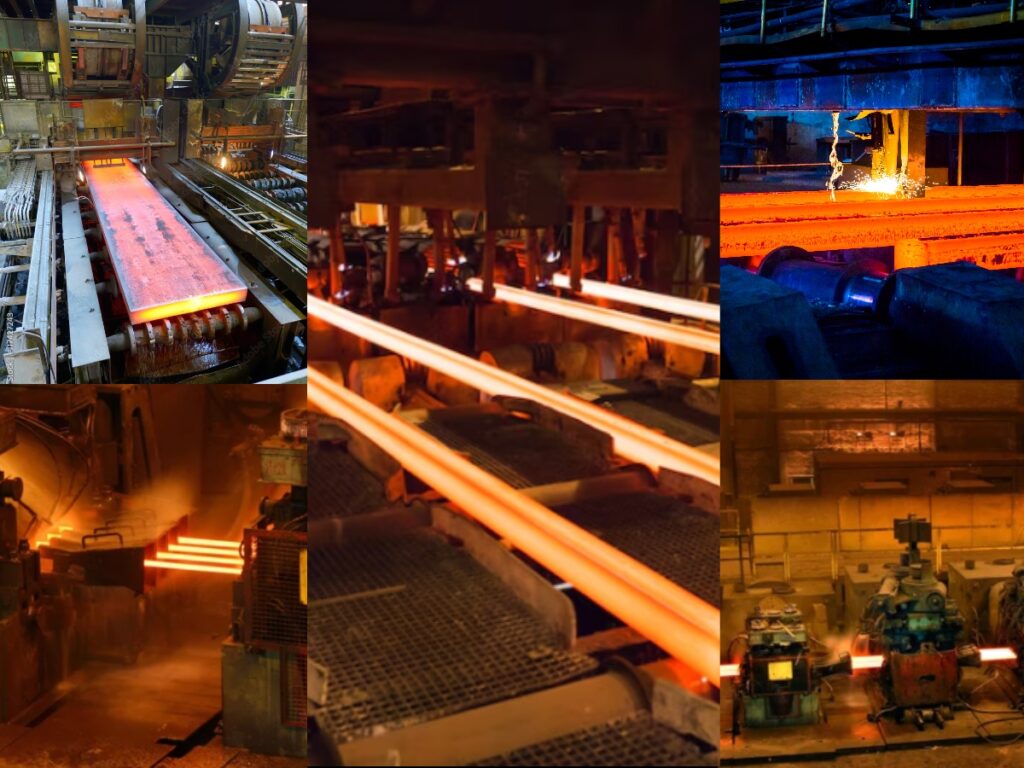
Finishing Stage:
From there, the metal passes through finishing in the finishing mill where smaller rollers are used. This is the stage where the metal is given the required thickness, width, and surface finish. The finishing mill is meant for high precision and a smooth surface to increase the quality of the final product. From the finishing mill, the metal goes to the cooling bed.
Cooling and Cutting Stage:
It then undergoes controlled cooling to stabilize the structure and mechanical properties. After cooling, the metal is cut into desirable length and size. After cutting, the metal proceeds for inspection and packaging. It thus ensures that the product is ready for the market.
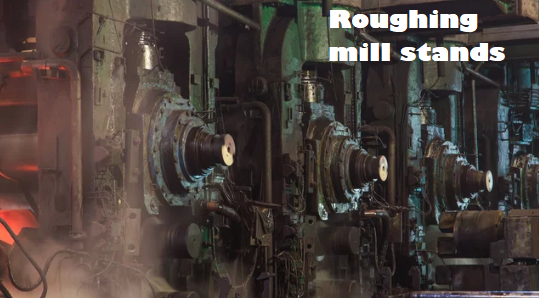
Major Components Working in a Hot Rolling Mill

Reheating Furnace:
The first significant part of major components working in the hot rolling mill is reheating furnaces. These heating furnaces heat raw metals—the slabs, billets, and blooms—to make them reach a rolling temperature of usually around 1100°C–1300°C. Proper heating makes the metal ductile so that it can easily attain the desired form and size after rolling. Reheating furnaces in state-of-the-art designs are available with energy efficiency and for homogeneous heating to ensure the quality of the end product. The temperature and atmosphere inside the furnace control is very vital for the grain structure and surface finish of the product.
Roughing Mill:
The role of a roughing mill is to reduce the reheated metal to its initial dimensions. Here, large rolls are used on the metal to decrease its thickness and increase its length. The roughing mill has a robust design for strength to work at high temperature and pressure conditions. After passing through this, the metal gets ready for subsequent hot rolling in terms of uniform thickness. Proper calibration and alignment ensure that the roughing mill performs as intended and that the final output is accurate.
Finishing Mill:
The finishing mill is the last stage in the process of hot rolling, where the reheated and pre-treated metal is given the required thickness, width, and surface finish. With high-speed rolls and precise controls, this mill imparts smooth and accurate dimensions to the final product. The quality and the alignment of rolls in the finishing mill directly impact the mechanical properties and surface quality of the product. This is the most critical stage because, as a rule, this is where the metal is given its final shape and hence its usability.
Cooling Bed:
Cooling bed is that part of the hot rolling mill where the finished metal is cooled under controlled conditions. Rapid cooling can have bad effects on the properties of metal hence the cooling bed helps to cool the metal in a gradual manner. This process ensures the mechanical properties as well as the dimensional stability of the product. The design of the cooling bed differs according to the size of metal as well as its production capacity, and it is integrated with automated systems for handling the finished products.
Coilers and Stackers:
After hot rolling, the finished products are bundled and organized by coilers or stackers. Coilers roll up and store thin strips or sheets while stackers arrange bars and rods in such a way to make the product easy and efficient for transportation and storage. These components combined with automation improve productivity and safety.
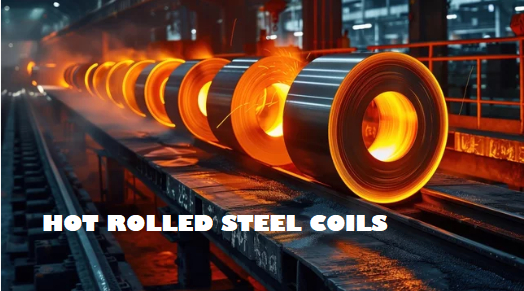
Products of Hot Rolling Mill
Hot Rolled Sheets and Plates:
One of the major products produced by a hot rolling mill is hot rolled sheets and plates. They are produced through the rolling of steel slabs at very high temperatures. They have a rough surface finish but ideal for further processing. They are mostly used in construction, shipbuilding, and heavy machinery manufacturing. These sheets and plates are thick and strong to sustain applications with high stress. They are also favored for the process of welding and fabrication, since they tend to be easy to shape and cut.
Hot Rolled Coils:
Hot rolled coils refer to the products obtained from hot rolling of the continuous strips in steel sheets, stockpiled in coil form. The products have an extensive use in automobile industries, pipelines, and structural applications. Hot-rolled coils have high strength and flexibility; hence, they are suitable for bending and forming processes. Their low cost and versatility make them a reliable option for diverse industries.
Hot Rolled Bars and TMT:
Hot rolled bars and TMT find application in construction and reinforcement. They have high tensile strength, a uniform cross-section, so they are good for beams, columns, and concrete reinforcement. The products are durable and corrosion-resistant to assure stability in the long term.
Advantages of Hot Rolling
Better material properties: In a hot rolling mill, the metal is rolled at a temperature higher than its recrystallization temperature. This refines the grain structure of the metal, increasing its mechanical properties—strength and ductility. Due to this process, all kinds of stress and internal defects in the material are eliminated; hence, the quality of the final product becomes very high and homogeneous. This technique is adopted in making several metals, such as steel, aluminum, and copper.
Cost Efficiency: Hot rolling is a relatively cheap process because the raw material is directly rolled without any additional heating. It is applied for large-scale production where low-cost processing of bulk materials is needed. The method maintains uniform thickness and dimensions of the material, so there is a reduction in the need for secondary processing, therefore reducing the cost.
Versatility and Large-Scale Applications: The hot rolling mill may be configured to produce products of various sizes and shapes, such as plates, bars, rods, and sheets of metals. This is good for manufacturing heavy-duty, high-strength materials that can be applied in several industries, including construction, automobiles, and machine manufacturing.
Conclusion
One of the most economical and effective methods in metal forming is the hot rolling mill. In this case, metals may be rolled under elevated temperatures that can provide metals with better properties than those arising from cold rolling that are strength and ductility. The hot rolling mill removes internal stress and defects found in the material; hence it results in quality and homogeneous output. This process serves the ideal large-scale production and finds a wide usage in construction, automotive, and machinery manufacturing industries. Its affordability and versatility make it just right for metals of different shapes and dimensions. Even though the surface finish of the products may be a little rough after hot rolling, further treatments will resolve the problem. In essence, the hot rolling mill is an asset to the industries that cannot be dispelled or done without.

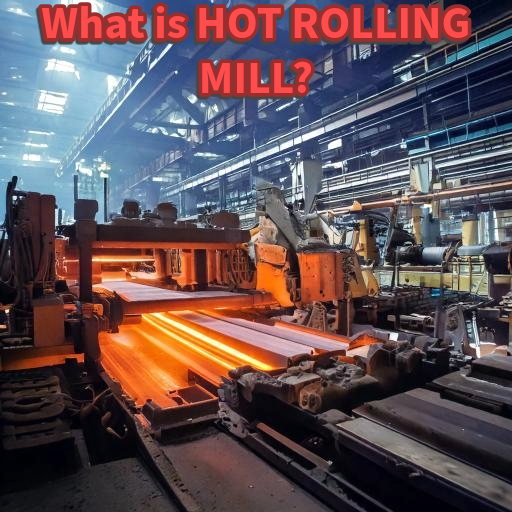

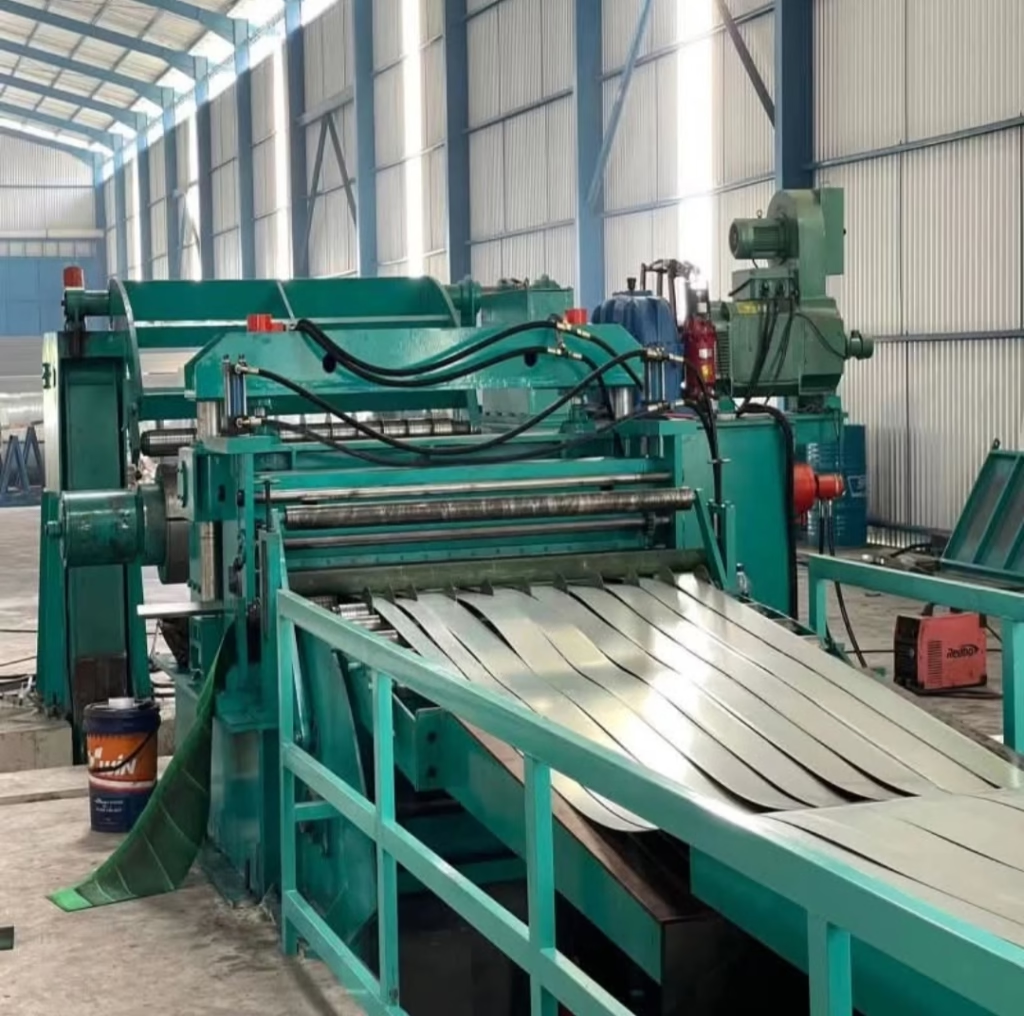
Pingback: STAINLESS STEEL PIPES & TUBES:- DETAILED INFORMATION
Pingback: STAINLESS STEEL FLAT AND ROUND BAR:- GRADE WISE APPLICTIONS
Pingback: TMT 500 STEEL BARS:- WHY WE USE IT IN CONSTRUCTION
Pingback: STAINLESS STEEL FLAT AND ROUND BAR:- GRADE WISE APPLICTIONS